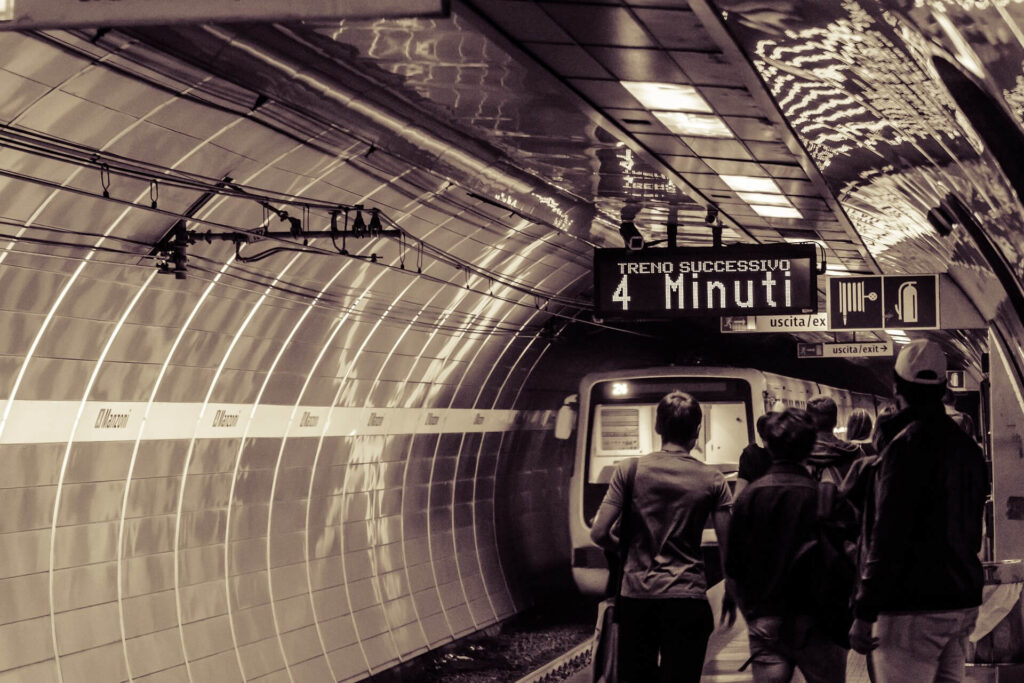Location: Central Cologne.
What is it? Cologne Cathedral, everyone knows this building. 157m high and the world’s third largest Gothic style cathedral. The Cologne Cathedral was built over the course of more than 600 years. Starting in year 1248. Actually completed not until 1880. Its construction required the usage of 300.000 tonnes of stones. Consisting of over 100.000 square metres of windows. The daily expense of maintenance comes to about 30.000€. The Three Wise Men’s (or Magi’s) relics are kept in the cathedral. The reason why Christians visit the cathedral. Can you imagine 20.000 visitors come here daily. This structure, is a UNESCO World Heritage Site. One of the most impressive churches in all of Europe. Its intricate spires pierce the sky, and its sheer size will leave you feeling in wonder.
Why to go? See the Cologne Cathedral, even if you’re not religious. The place that will leave you astonished. Consider taking in the ascending the twisted stairway to the summit for city vistas. You will remember your visit to the Cologne Cathedral.
Location: Deutz District, across the Rhine River from Center.
Open: Daily, 10am to 8pm (last admission at 7.30pm).
What is it? Enter the Cologne Triangle, a modern wonder. Leave behind the traditional elegance of the Cologne Cathedral. In big contrast to the Gothic architecture of the city center. 265 meters (870 feet) above the ground. This tall, triangular skyscraper has 360 degree views of Cologne and the Rhine River. The Cologne Triangle is the highest structure in the city. A tribute to Cologne’s nautical past. The building is shaped like a ship’s prow.
Why to go? The Cologne Triangle is the place to go if you want to give your visit to Cologne a contemporary spin. Ride up the high speed elevator to the summit. Watch the views that go on for miles. Experience Cologne’s a panoramic viewpoint by exploring the Cologne Triangle.
Location: Central Cologne.
What is it? Take a trip down memory lane while exploring Cologne’s Old Town’s labyrinth. The half timbered buildings lining the cobblestone streets whisper tales of a the past. Adorable cafes overflow into bright squares. Inviting you to enjoy a cup of coffee and take in the ambience. There is a hidden treasure to be found around every corner. Whether it is a museum, an old cathedral, or an boutique filled with local items. Despite the fact that the Old Town was largely crushed during World War II. It was restored, keeping its historic integrity for future generations. Here, amidst the half timbered homes are several Romanesque churches that proudly display remnants of Cologne’s Roman heritage.
Why to go? Cologne’s heart is the Old Town. It’s a place to lose yourself in the past, get lost in the streets. Understanding Cologne’s authentic character and traveling back in time can be achieved by the Old Town.
Location: Departures from different points along the Rhine River.
Open: Daily, 10am to 6pm.
What is it? Sail through the center of Cologne on the Rhine River. The scenery is dotted with villages and hills. Giving an idea of the grandeur of the German countryside as the city skyline gradually disappears. Cruises for sightseeing will highlight architectural and historical sites. While dinner cruises will let you enjoy a meal outside as you take in the surroundings. The Rhine River has been an important commercial artery linking Cologne with other major European towns for ages. The natural of the Rhine Valley has long captivated the attention of painters, writers, and poets. Inspiring them with a multitude of creative expressions.
Why to go? Journey down the Rhine River. Here you have a great opportunity to get a new view on Cologne. Cruises offer a getaway from the activity of the city. Letting you decompress and appreciate the natural beauty of Cologne’s landscape.
Location: Central Cologne.
What is it? Wander across the Hohenzollern Bridge. Spaning the Rhine River and serving as both a railroad and pedestrian bridge. Even while the bridge’s neo gothic style is noticeable its most well known custom is its use of love locks. The bridge’s railings are covered in thousands of padlocks that are engraved with the names and dreams of lovers. All of them making it an enchanting sight. Today around 40.000 love locks have been attached to the Hohenzollern Bridge. Together they weigh around 22 tons. However, the bridge itself weighs 24.000 tons and is suitable for heavy trains. After being damaged during World War II, the Hohenzollern Bridge was eventually restored. Photographers will find the bridge to be the ideal location. The view go to both the Old Town and the Cologne Cathedral.
Why to go? The Hohenzollern Bridge is worth seeing, regardless of whether you’re a lover, an bystander, or just someone seeking breathtaking views. See the volume of expressions of love. Perhaps adding your own padlock.
Location: Central Cologne.
Open: Tuesday to Sunday, 10am to 6pm (closed on Mondays).
Ticket Fee: Entrance fee applies (check their website for current prices).
What is it? The NS Documentation Centre is a museum dedicated to the history of National Socialism in Cologne and the Rhineland region. By permanent exhibits, photographs, and personal stories. The rise of the Nazi party is studied at the museum. The terrible effects of World War II and the persecution of minorities. Although it’s a painful experience, learning about the nuances of German history is necessary. The museum is located on the site of the former Gestapo headquarters. From 1935 to 1945, the Cologne Gestapo’s headquarters were located at the EL DE House on Appellhofplatz. The NS Documentation Centre is a key resource for education and remembrance. Ensuring the dark chapters of history are never forgotten.
Why to go? Simple solutions are not accessible at the NS Documentation Centre. It’s a space for facing the dark past. Consider seeing objects used by the Nazi dictatorship or learning about the experiences of Cologne citizens during World War II. The museum is a symbol of the pitfalls of racism and the necessity of fighting for a fair and harmonious future.
Location: Central Cologne.
Open: Tuesday to Sunday, 10am to 6pm (closed on Mondays).
Ticket Fee: Entrance fee applies (check their website for current prices).
What is it? The Wallraf Museum welcomes you to get up close and personal with the art of Europe. The museum is home to one of the best collections of medieval paintings. Yes, in the entire globe. “Madonna of the Rose Bower” by Stefan Lochner is one of the pieces. Followed by the Baroque masters, such as Rembrandt, Rubens, and Boucher. As well as French Realism, Impressionism, and the German Romantics. These are just a few highlights. Start a journey through 700 years of art and history. The Wallraf Richartz Museum is the largest collection of impressionist and neo impressionist artwork in Germany. Thanks to the paintings from the Fondation Corboud. Outstanding works by Manet, Monet, Renoir, Pissarro, Sisley, Morisot, Signac, and Seurat are all represented here. While the modernist movement is recognized by Munch, Cezanne, Gauguin, Bonnard, Ensor, and van Gogh. The museum’s collection began with a donation of just a few paintings in the 1820s. Nowadays grown into a big collection over 100.000 works.
Why to go? The Wallraf Richartz Museum offers a wealth of information for everyone. Get lost in impressionist painting’s hues, medieval sculpture’s detail, and so much detail. Stroll through the hallways and allow the art speak to you.
Location: Central Cologne.
Open: Daily, 10am to 6pm.
Ticket Fee: Entrance fee applies (check their website for current prices).
What is it? “You’ll like them” is a favorite quote in the film Chocolat, seducing millions of film fans. The 650.000 annual visitors to the Chocolate Museum in Cologne are treated to over 4.000 tours. When more senses are added to the visual experience, the interest level increases. Served by giving the chocolate a taste. This interactive wonderland has all things chocolate. Beginning with the development of its production. Interactive displays that highlight the process of creating chocolate, illustrating the evolution of a cocoa bean from jungle seed to delicious treat. Watch how chocolate is made in front of your eyes! Concluding with a taste, of course. Prepare to have your senses tempted by chocolate flavors from the entire globe. The largest chocolate fountain in the world is located inside the Schokoladenmuseum. Picture a gigantic waterfall of melt in your mouth goodness.
Why to go? Anyone with a sweet tooth and let’s face it, who doesn’t? Visit the Schokoladenmuseum. Enjoy a delicious chocolate tasting. For visitors of all ages, the museum is an enjoyable and engaging experience that provides a lovely alternative from the typical touring itinerary.
Location: Central Cologne.
Open: Tuesday to Sunday 10am to 6pm (closed on Mondays).
Ticket Fee: Entrance fee applies (check their website for current prices).
What is it? Goethe, Napoleon, Voltaire, Bill Clinton all of them used “Eau de Cologne”. Johann Maria Farina was an Italian who actually invented the real, original eau de cologne. Farina developed a scent that would take him back to his native country. He was looking for more pleasant experiences that over 300 years ago’s Cologne could offer. His goal was creating a scent that smelled “like a spring morning in Italy after the rain”. Farina House, is the oldest fragrance factory still in operation in the world. Established July 13, 1709. The Farina company still decorates every product with a red tulip to this day. It was inspired by the rarity and high cost of tulips in the early 18th century.
Why to go? Anyone with a sense of smell, which, let’s face it, is all of us, will find the Fragrance Museum to be an scent sational journey. Explore exhibits by sniffing, learning the backstories of your favorite fragrances. Maybe even developing your own unique aroma. The museum presents the science of smell and how it has influenced human history and society.
Location: Throughout Cologne.
Open: Varies depending on the specific restaurant or brewery.
Ticket Fee: Pay for your food and drinks.
What is it? Sit inside a Cologne Pub, a Kölsch (pronounced “Kolsch”) beer in hand, and a Halve Hahn (literally “half rooster”) bread roll in the other hand. The foundation of Cologne’s culinary culture is this duo. Strict guidelines are followed in the brewing of Kölsch, a light pale ale that is served in an thin glass. Kölsch beer is so essential to Cologne culture, there are many bar called “Brauhaus” that serve primarily Kölsch beer. Halve Hahn is a bread cut open and stuffed with cheese, mustard, and other toppings. Though it doesn’t really contain any chicken. The Halve Hahn bread roll originates its name from its analogy to the head and neck of a rooster.
Why to go? Try the local beer, Kölsch, and bread Halve Hahn, is a must when visiting Cologne. Enjoy these regional specialties while clinking glasses with friends. It’s an opportunity to have an authentic Cologne gastronomic experience.



















